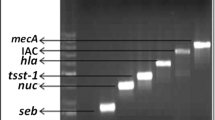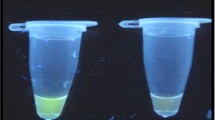Abstract
In spite of their involvement in foodborne illness, the epidemiological relevance of staphylococcal enterotoxin C (SEC) subtypes is poorly documented may be due to high sequence similarity. Among subtypes, SEC1, SEC2, and SEC3 exhibit more than 97 % homology because of which specific detection tools are seldom available to identify and differentiate them. In this study, a SYBR Green-based RT-PCR followed by melt curve analysis was developed for differentiation of entC1 from entC2/entC3 using a single primer pair. Nucleotide sequences of all three subtypes were analyzed using Clustal Omega program and the region with significant sequence variation/heterogeneity (where utmost SNPs were closely located and accessible for RT-PCR) was selected for amplification by designing a single primer pair that could amplify all three subtypes. In spite of same amplicon size, entC1 showed distinct melt peak at 76 °C. However, due to high similarity between entC2 and entC3, the developed format was deficient to discriminate between them and both showed melt peak at 82 °C. Reliability of developed RT-PCR was evaluated using various naturally contaminated samples and 91 food and clinical Staphylococcus aureus isolates where satisfactory results were obtained in comparison with commercial immunoassay kit and conventional PCRs using validated primers. To the best of our knowledge, this is the first method being reported to differentiate entC1 from entC2/entC3 using single primer pair which is unachievable by conventional PCR due to same amplicon size. As benefits, the method is sensitive, rapid, and inexpensive with no requirement of fluorescent probes, multiple primers, and post-PCR procedures. Thus, the assay might find its utility as a detection tool in epidemiological survey of foodborne outbreaks for simultaneous identification and differentiation of entC1 from entC2/entC3.




Similar content being viewed by others
References
Ataee RA, Mohammad HA, Gholam HA, Davoud E (2014) Staphylococcal enterotoxin C in synovial fluid of patients with rheumatoid arthritis. Iran Red Crescent Med J 16(10):e16075
Balaban N, Rasooly A (2000) Staphylococcal enterotoxins. Int J Food Microbiol 61(1):1–10
Betley MJ, Borst DW, Regassa LB (1992) Staphylococcal enterotoxins, toxic shock syndrome toxin and streptococcal pyrogenic exotoxins: a comparative study of their molecular biology (part 1 of 2). Chem Immunol 55:1–18
Beuret C (2004) Simultaneous detection of enteric viruses by multiplex real-time RT-PCR. J Virol Methods 115(1):1–8
Bohach GA, Dinges MM, Mitchell DT, Ohlendorf DH, Schlievert PM (1997) Exotoxins. The staphylococci in human disease. Churchill Livingstone, New York, pp. 83–111
Bohach GA, Fast DJ, Nelson RD, Schlievert PM (1990) Staphylococcal and streptococcal pyrogenic toxins involved in toxic shock syndrome and related illnesses. Crit Rev Microbiol 17(4):251–272
Bohach GA, Schlievert PM (1989) Conservation of the biologically active portions of staphylococcal enterotoxins C1 and C2. Infect Immun 57(7):2249–2252
Bru D, Martin-Laurent F, Philippot L (2008) Quantification of the detrimental effect of a single primer-template mismatch by real-time PCR using the 16S rRNA gene as an example. Appl Environ Microbiol 74(5):1660–1663
Chen TZ (2001) The exploitation of HAS and its application in tumor therapy. Prog Microbiol Immun China 29:63–69
Chen TR, Hsiao MH, Chiou CS, Tsen HY (2001) Development and use of PCR primers for the investigation of C1, C2 and C3 enterotoxin types of Staphylococcus aureus strains isolated from food-borne outbreaks. Int J Food Microbiol 71(1):63–70
Chu C, Yu C, Lee Y, Su Y (2012) Genetically divergent methicillin-resistant Staphylococcus aureus and sec-dependent mastitis of dairy goats in Taiwan. BMC Vet Res 8(1):1
Da Silva ER, do Carmo LS, Da Silva N (2005) Detection of the enterotoxins A, B, and C genes in Staphylococcus aureus from goat and bovine mastitis in Brazilian dairy herds. Vet Microbiol 106(1):103–107
Deringer JR, Ely RJ, Stauffacher CV, Bohach GA (1996) Subtype-specific interactions of type C staphylococcal enterotoxins with the T-cell receptor. Mol Microbiol 22(3):523–534
Dong S, Luo G, Feng J, Li Q, Gao H (2001) Immunoassay of staphylococcal enterotoxin C1 by FTIR spectroscopy and electrochemical gold electrode. Electroanalysis 13(1):30–33
Gao Z, Chao F, Chao Z, Li G (2000) Detection of staphylococcal enterotoxin C2 employing a piezoelectric crystal immunosensor. Sensors Actuators B Chem 66(1):193–196
Guy RA, Xiao C, Horgen PA (2004) Real-time PCR assay for detection and genotype differentiation of Giardia lamblia in stool specimens. J Clin Microbiol 42(7):3317–3320
Hsiao MH, Chen TR, Tsen HY (2003) Novel PCR primers for specific detection of C1, C2 and C3 enterotoxin genes in Staphylococcus aureus. J Food Drug Anal 11:239–245
Hosmillo MD, Jeong YJ, Kim HJ, Collantes TM, Alfajaro MM, Park JG, Kim HH, Kwon HJ, Park SJ, Kang MI, Park SI (2010) Development of universal SYBR Green real-time RT-PCR for the rapid detection and quantitation of bovine and porcine toroviruses. J Virol Methods 168(1):212–217
Hovde CJ, Hackett SP, Bohach GA (1990) Nucleotide sequence of the staphylococcal enterotoxin C3 gene sequence comparison of all three type C staphylococcal enterotoxins. Mol Gen Genomics 220:329–333
Huang Y, Chen X, Duan N, Wu S, Wang Z, Wei X, Wang Y (2015) Selection and characterization of DNA aptamers against Staphylococcus aureus enterotoxin C1. Food Chem 166:623–629
Hun X, Zhujun Z (2007) A novel sensitive staphylococcal enterotoxin C1 fluoroimmunoassay based on functionalized fluorescent core-shell nanoparticle labels. Food Chem 105:1623–1629
Marr JC, Lyon JD, Roberson JR, Lupher M, Davis WC, Bohach GA (1993) Characterization of novel type C staphylococcal enterotoxins: biological and evolutionary implications. Infect Immun 61(10):4254–4262
Marrack P, Kappler J (1990) The staphylococcal enterotoxins and their relatives. Science 248(4956):705–711
Ming-Kai X, Cheng-Gang Z (2006) Gene expression and function study of fusion immunotoxin anti-Her-2-scFv—SEC2 in Escherichia coli. Appl Microbiol Biotechnol 70(1):78–84
Mizukane R, Nakatomi M, Futsuki Y, Araki J, Asai S, Sawatari K, Hirakata Y, Maesaki S, Tomono K, Kohno S (1998) A study of virulence factors produced by MRSA strains isolated from blood samples. Kansesshogaku Zasshi Jansenshogaku Zasshi 72(8):788–793
Nagaraj S, Ramlal S, Sripathy MH, Batra HV (2014) Development and evaluation of a novel combinatorial selective enrichment and multiplex PCR technique for molecular detection of major virulence-associated genes of enterotoxigenic Staphylococcus aureus in food samples. J Appl Microbiol 116(2):435–446
Normanno G, Firinu A, Virgilio S, Mula G, Dambrosio A, Poggiu A, Decastelli L, Mioni R, Scuota S, Bolzoni G, Di Giannatale E (2005) Coagulase-positive staphylococci and Staphylococcus aureus in food products marketed in Italy. Int J Food Microbiol 98(1):73–79
Reiser RF, Robbins RN, Noleto AL, Khoe GP, Bergdoll MS (1984) Identification, purification, and some physicochemical properties of staphylococcal enterotoxin C3. Infect Immun 45(3):625–630
Richards GP, Watson MA, Kingsley DH (2004) A SYBR Green, real-time RT-PCR method to detect and quantitate Norwalk virus in stools. J Virol Methods 116(1):63–70
Ririe KM, Rasmussen RP, Wittwer CT (1997) Product differentiation by analysis of DNA melting curves during the polymerase chain reaction. Anal Biochem 245(2):154–160
Sambrook J, Russell DW (1989) Molecular cloning: a laboratory manual, vol 3. Cold Spring Harbor Laboratory Press, Cold Spring Harbor
Schmitz FJ, Steiert M, Hofmann B, Verhoef J, Hadding U, Heinz HP, Köhrer K (1998) Development of a multiplex-PCR for direct detection of the genes for enterotoxin B and C, and toxic shock syndrome toxin-1 in Staphylococcus aureus isolates. J Med Microbiol 47(4):335–340
Theron J, Cilliers J, Du Preez M, Brözel VS, Venter SN (2000) Detection of toxigenic Vibrio cholerae from environmental water samples by an enrichment broth cultivation–pit-stop semi-nested PCR procedure. J Appl Microbiol 89(3):539–546
Tibana A, Rayman K, Akhtar M, Szabo R (1987) Thermal stability of staphylococcal enterotoxins A, B and C in a buffered system. J Food Prot 50(3):239–242
Varga A, James D (2005) Detection and differentiation of plum pox virus using real-time multiplex PCR with SYBR Green and melting curve analysis: a rapid method for strain typing. J Virol Methods 123(2):213–220
Wang JY, Huang TP, Chang YC, Shih DYC (2003) Subtyping of enterotoxin C strains isolated from food poisoning outbreaks in Taiwan. J Food Drug Anal 11(3):239–245
Wang X, Xu M, Zhang H, Liu J, Li X, Zhang C (2009) Enhancement of superantigen activity and antitumor response of staphylococcal enterotoxin C2 by site-directed mutagenesis. Cancer Immunol Immunother 58 (5):677–686
Wehrle E, Didier A, Moravek M, Dietrich R, Martlbauer E (2009) Detection of Bacillus cereus with enteropathogenic potential by multiplex real-time PCR based on SYBR Green I. Mol Cell Probes 24(3):124–130
Zhou J, Liu L, Xu M, Zhang H, Zhang Y, Zhang C (2013) T-cell proliferation and antitumour activities of a truncated mutant of staphylococcal enterotoxin C2 with decreased cytokine secretion. J Med Microbiol 62(3):451–456
Zorgani A, Essery SD, Madani O, Bentley AJ, James VS, MacKenzie DA, Keeling JW, Rambaud C, Hilton J, Blackwell CC, Weir DM (1999) Detection of pyrogenic toxins of Staphylococcus aureus in sudden infant death syndrome. FEMS Immunol Med Microbiol 25(1–2):103–108
Acknowledgments
The authors are grateful to DRDO for providing the necessary facilities to carry out this work.
Author information
Authors and Affiliations
Corresponding author
Ethics declarations
Conflict of interest
The authors declare that they have no conflict of interest.
Ethics statement
This article does not contain any studies with human participants or animals performed by any of the authors.
Electronic supplementary material
ESM 1
(PDF 274 kb)
Rights and permissions
About this article
Cite this article
Nagaraj, S., Ramlal, S., Venkataswamachari, B.P. et al. Differentiation of entC1 from entC2/entC3 with a single primer pair using simple and rapid SYBR Green-based RT-PCR melt curve analysis. Appl Microbiol Biotechnol 100, 8495–8506 (2016). https://doi.org/10.1007/s00253-016-7637-y
Received:
Revised:
Accepted:
Published:
Issue Date:
DOI: https://doi.org/10.1007/s00253-016-7637-y




